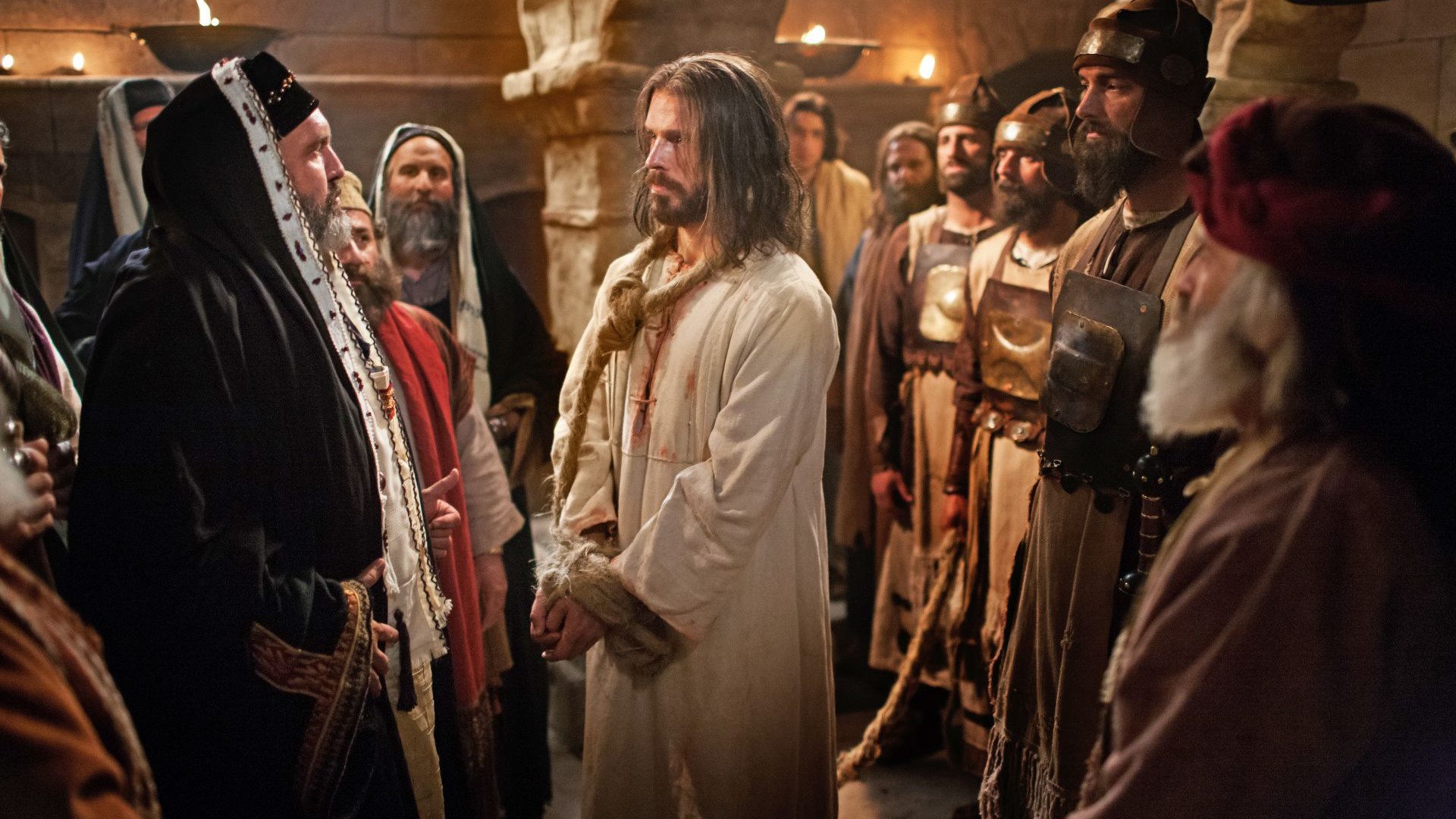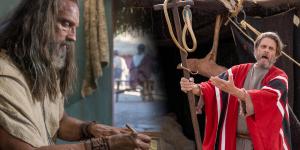You are here
Why Was Jesus Put On Trial and Crucified?

Mark 15:1
The Know
After Jesus suffered for the sins of the world in Gethsemane, “Judas, one of the twelve, came, and with him a great multitude with swords and staves, from the chief priests and elders of the people” (Matthew 26:47). Upon willingly submitting Himself to this mob, Jesus endured several flurried and hasty trials. These include His arraignments before the Sanhedrin, Pilate, and Herod.
Precisely what rationale led to these judicial proceedings isn’t fully clear from the scriptural record. As John W. Welch has noted, “one runs directly into several stubborn problems” when trying to ascertain motivations behind the actions of the chief priests and other key players in these activities.1 For instance, Matthew and Mark each state that the Sanhedrin delivered Jesus over to Pilate “for envy” (see Mark 15:10; Matthew 27:18), which Pilate misunderstood for some petty motivation. Yet even feelings of envy do not adequately describe the reactions exhibited by the Sanhedrin at Jesus’s trial.2
Welch thus reasoned that fear was likely a greater driving factor, “particularly fear of Jesus’s miraculous powers.” Specifically, fear of the occult appears to have followed closely behind many of the miracles Jesus performed, as the Pharisees woefully misunderstood the source of Jesus’s divine powers.3 This helps explain why throughout Jesus’s ministry, His faith-inspiring miracles were almost always followed by a strong reaction from the Pharisees, who accused Him of using the powers of Beelzebub and who repeatedly sought to take His life (see Matthew 12:24–28). Thus, as Welch observed, “behind everything here lurks a strong undercurrent of misplaced fear that Jesus was an evil magician.”4
Notably, both the Bible and Book of Mormon establish a link between Jesus’s miracles and His trials. John wrote that before deciding to put Jesus to death, the chief priests and Pharisees asked, “What do we? for this man doeth many miracles” (John 11:47–53). Similarly, both Jacob and King Benjamin connected Jesus’s working of “mighty miracles” with His death at the hands of wicked men (2 Nephi 10:4–5; Mosiah 3:5, 9).
As a part of these fear-driven trials, multiple charges were leveled against Jesus in an effort to exact Roman punishment. These included accusations such as blasphemy, and they often relied on false witnesses or strained interpretations of the law. Several of these charges pertain to Christ’s temple-related teachings and activities (see Matthew 26: 59–66). Still, the predominant theme among these charges is Jesus’s miracles rather than any doctrines He taught.
After the trials, “the chief priests held a consultation with the elders and scribes and the whole council, and bound Jesus, and carried him away, and delivered him to Pilate” (Mark 15:1) with the intent that “he might find Jesus similarly guilty under Roman law of sedition (crimen maiestatus) through illicit magical wonder-working (maleficum).”5
As noted by Welch, purported magical practice was “a serious offence under Roman law at the time of Jesus, especially when it threatened in any way the security of the emperor.”6 It is for this reason that the chief priests said that Jesus “speaketh against Caesar” in addition to other treasonous charges (John 19:12; cf. Luke 23:2). These outlawed forms of prophecy and miracle working “had recently become punishable by death” by a decree of Augustus Caesar in AD 11, preventing anyone from speaking against, prophesying against, or performing any ritual action against the emperor.7 Pilate, of course, found Jesus guilty of no such charge—but still the chief priests pressed for Jesus’s execution, as false prophecy and miracle working were likewise forbidden under Jewish law.
Clearly, fear of Jesus’s miracles did not end with His Crucifixion. Worried that Jesus would “somehow appear to rise after three days as He prophesied that He would,” the Pharisees planted a guard at the tomb of Jesus to be sure that nothing of the sort could happen. Interestingly, these individuals called Jesus a “trickster” or “deceiver,” utilizing the same Greek word (planos) to describe “one who deceives by seduction through evil powers or spirits.” This same word was used in early Jewish and Christian literature and scripture to describe Satan, demons, and false prophets, especially those who performed miracles such as “raising mountains, churning up the sea, [and] raising the dead.”8
Finally, viewing Jesus’s trial in the context of fear of demonic powers also helps “explain the legal puzzles of the Crucifixion and the lack of legal formalities.” After all, as the New Testament itself witnesses, “the normal form of execution for blasphemy under Jewish law was stoning; and several times people took up stones thinking to stone Jesus for blasphemy.”9 However, thanks to the discovery of the Dead Sea Scrolls, “scholars now acknowledge that hanging on a tree (or crucifixion) could serve in Jesus’ day … as a mode of execution under the prevailing Jewish law.”10
Such a method of execution was likewise used just a century before the time of Jesus. In that notorious case, “eighty witches were hung or crucified in Ashkelon without proper trials because the court saw the matter as a matter of emergency.” While the later Talmudic writers condemned this trial as an illegal act of a wicked court, this case is important in showing that rushed (even nonexistent) trials were performed by frightened Jewish leaders, resulting in the condemned being crucified.11 Jesus’s rushed trial and execution mirrors this event.12
The Why
As Jesus’s trials progressed through the night, fear seemed to settle in on all fronts. Jesus’s own disciples fled from Gethsemane, and Peter—perhaps out of fear—denied his association with Jesus as he was relentlessly questioned by the servants of the High Priest.13 Even Pilate and Herod demonstrated fear at some point throughout this trial: Pilate, already afraid of a violent tumult, was met with warnings from his wife because of dreams she had had regarding Jesus (see Matthew 27:19, 24). Herod, likewise, may have initially been frightened of Jesus’s miraculous power, just as he had feared John the Baptist and the multitude that followed him (Matthew 14:5; Mark 6:20).
It is also sadly ironic that the very thing that so clearly proved Jesus’s divinity—His good and miraculous works—was so influential in His martyrdom. The multi-faceted fears of the Jewish rulers blinded them from discerning the goodness and power of God as manifested through Jesus Christ. They were too proud, too certain of their own conclusions, and far too afraid of losing their power, influence, and control.
That is not the end of the story, however. Jesus did not ultimately allow Himself to be crucified because of these misplaced fears, but He willingly sacrificed Himself for us: “I lay down my life, that I might take it again. No man taketh it from me, but I lay it down of myself” (John 10:17–18). Jesus’s infinite and eternal sacrifice was always God’s plan, allowing us to overcome all our fears as we come to Him.
“There is no fear in love,” the Apostle John wrote, “but perfect love casteth out fear” (1 John 4:18). Christ’s pure love is manifest to all of God’s children and helps us to overcome our fears, worries, and anxieties. These fears that hold us back can therefore be replaced by faith, allowing us to “come boldly unto the throne of grace, that we may obtain mercy,” which is available to us through Christ’s suffering, death, and Resurrection (Hebrews 4:16).
Further Reading
John W. Welch, “Miracles, Maleficium, and Maiestas in the Trial of Jesus,” in Jesus and Archaeology, ed. James H. Charlesworth (Grand Rapids, MI: Eerdmans, 2006), 349–383.
John W. Welch, “The Legal Cause of Action Against Jesus in John 18:29–30,” in Celebrating Easter: The 2006 BYU Easter Conference, ed. Thomas A. Wayment and Keith J. Wilson (Provo, UT: Religious Studies Center, Brigham Young University), 157–175.
John W. Welch, “The Factor of Fear in the Trial of Jesus,” in Jesus Christ: Son of God, Savior, ed. Paul H. Peterson, Gary L. Hatch, and Laura D. Card (Provo, UT: Religious Studies Center, Brigham Young University; Salt Lake City, UT: Deseret Book, 2002), 284–312.
Bernard S. Jackson, “The Trials of Jesus and Jeremiah,” BYU Studies Quarterly 32, no. 4 (1992): 63–77.
- 1. John W. Welch, “The Factor of Fear in the Trial of Jesus,” in Jesus Christ: Son of God, Savior, ed. Paul H. Peterson, Gary L. Hatch, and Laura D. Card (Provo, UT: Religious Studies Center, Brigham Young University; Salt Lake City, UT: Deseret Book, 2002), 286.
- 2. See Welch, “Factor of Fear,” 288–289.
- 3. Welch, “Factor of Fear,” 285, 297.
- 4. Welch, “Factor of Fear,” 299.
- 5. John W. Welch, “Miracles, Maleficium, and Maiestas in the Trial of Jesus,” in Jesus and Archaeology, ed. James H. Charlesworth (Grand Rapids, MI: Eerdmans, 2006), 350.
- 6. Welch, “Miracles, Maleficium, and Maiestas,” 369–370.
- 7. Welch, “Miracles, Maleficium, and Maiestas,” 370.
- 8. Welch, “Factor of Fear,” 301; cf. Welch, “Miracles, Maleficium, and Maiestas,” 364.
- 9. Welch, “Factor of Fear,” 306, citing John 8:59; cf. Welch, “Miracles, Maleficium, and Maiestas,” 381.
- 10. Welch, “Factor of Fear,” 307; cf. Welch, “Miracles, Maleficium, and Maiestas,” 381–382.
- 11. Welch, “Factor of Fear,” 307; cf. Welch, “Miracles, Maleficium, and Maiestas,” 382.
- 12. The idea that Jesus was an illicit miracle worker or magician is so prominent that it even persists to this day. Those who claim this today often misunderstand Jesus’s divine powers and priesthood and similarly misunderstand the Gospel accounts of Jesus’s life as well as the early Christian portrayals of Jesus. For brief responses to these claims that Jesus was nothing more than a magician, see Barry Crawford, “Review of Jesus the Magician by Morton Smith,” Journal of the American Academy of Religion 47, no. 2 (1979): 321–322; Lee M. Jefferson, “Jesus the Magician? Why Jesus Holds a Wand in Early Christian Art,” Biblical Archaeology Review 46, no. 4 (2020): 41–47.
- 13. See Book of Mormon Central, “Why Did Peter Deny Knowing Jesus? (Matthew 26:34),” KnoWhy 673 (May 30, 2023).
KnoWhy Citation
Related KnoWhys
Subscribe
Get the latest updates on Book of Mormon topics and research for free





